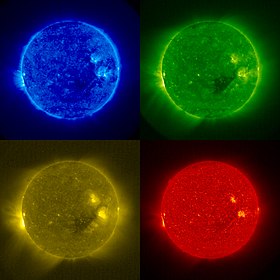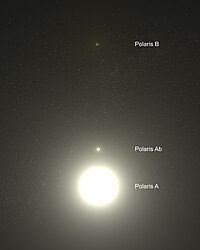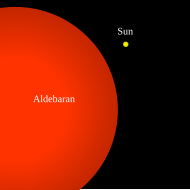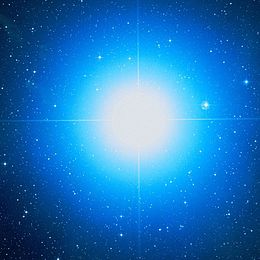Portal:Stars/Selected stars
If you found any nice article of a particular star, do make a link here.
Usage
[edit]- Add a new selected article to the next available subpage. [[Portal:Star/Selected stars/#]] - {{/#}}
- Update "max=" to new total for its {{Random portal component}} on the main page.
Nominations
[edit]Please see Portal:Stars/Nominate/Selected stars for nominations.
Selected articles list
[edit]
Mira, /ˈmaɪrə/, also known as Omicron Ceti (or ο Ceti / ο Cet), is a red giant star estimated 200-400 light years away in the constellation Cetus. Mira is a binary star, consisting of the red giant Mira A along with Mira B. Mira A is also an oscillating variable star and was the first non-supernova variable star discovered, with the possible exception of Algol. Apart from the unusual Eta Carinae, Mira is the brightest periodic variable in the sky that is not visible to the naked eye for part of its cycle. Its distance is uncertain; pre-Hipparcos estimates centered around 220 light-years, while Hipparcos data suggests a distance of 418 light-years, albeit with a margin of error of ~14%.
Evidence that the variability of Mira was known in ancient China, Babylon or Greece is at best only circumstantial. In 1638 Johannes Holwarda determined a period of the star's reappearances, eleven months; he is often credited with the discovery of Mira's variability. Johannes Hevelius was observing it at the same time and named it "Mira" (meaning "wonderful" or "astonishing," in Latin) in 1662's Historiola Mirae Stellae, for it acted like no other known star. Ismail Bouillaud then estimated its period at 333 days, less than one day off the modern value of 332 days (and perfectly forgivable, as Mira is known to vary slightly in period, and may even be slowly changing over time). The star is estimated to be a 6 billion year old red giant.

Betelgeuse is a semiregular variable star located approximately 640 light-years from the Earth. With an apparent magnitude ranging between 0.3 and 1.2, it is the ninth brightest star in the night sky. Although Betelgeuse has the Bayer designation Alpha Orionis (α Orionis / α Ori), it is most often the second brightest star in the constellation Orion behind α; Rigel (Beta Orionis) is usually brighter (Betelgeuse is a variable star and is on occasion brighter than Rigel). The star marks the upper right vertex of the Winter Triangle and center of the Winter Hexagon.
Betelgeuse is a red supergiant, and one of the largest and most luminous stars known. For comparison, if the star were at the center of the Solar System its surface might extend out to between the orbits of Mars and Jupiter, wholly engulfing Mercury, Venus, the Earth and Mars. The angular diameter of Betelgeuse was first measured in 1920–1921 by Albert Abraham Michelson and Francis G. Pease using the 100 inch (2.5 m) John D. Hooker astronomical interferometer telescope atop Mount Wilson Observatory.
Astronomers believe Betelgeuse is only a few million years old, but has evolved rapidly because of its high mass. Due to its age, Betelgeuse may go supernova within the next millennium (because it is hundreds of light years away, it possibly may have done so already).

The Sun is the star at the center of the Solar System. The Sun has a diameter of about 1,392,000 kilometers (865,000 mi) (about 109 Earths), and by itself accounts for about 99.86% of the Solar System's mass; the remainder consists of the planets (including Earth), asteroids, meteoroids, comets, and dust in orbit. About three-quarters of the Sun's mass consists of hydrogen, while most of the rest is helium. Less than 2% consists of other elements, including iron, oxygen, carbon, neon, and others.
The Sun's color is white, although from the surface of the Earth it may appear yellow because of atmospheric scattering. Its stellar classification, based on spectral class, is G2V, and is informally designated a yellow star, because the majority of its radiation is in the yellow-green portion of the visible spectrum. In this spectral class label, G2 indicates its surface temperature of approximately 5,778 K (5,505 °C), and V (Roman five) indicates that the Sun, like most stars, is a main sequence star, and thus generates its energy by nuclear fusion of hydrogen nuclei into helium.

Sirius is the brightest star in the night sky. With a visual apparent magnitude of −1.46, it is almost twice as bright as Canopus, the next brightest star. The name "Sirius" is derived from the Ancient Greek Seirios ("scorcher"), possibly because the star's appearance was associated with summer. The star has the Bayer designation α Canis Majoris (α CMa, or Alpha Canis Majoris). What the naked eye perceives as a single star is actually a binary star system, consisting of a white main sequence star of spectral type A1V, termed Sirius A, and a faint white dwarf companion of spectral type DA2, termed Sirius B.
Sirius appears bright due to both its intrinsic luminosity and its closeness to the Earth. At a distance of 2.6 parsecs(8.6 ly), the Sirius system is one of our near neighbors. Sirius A is about twice as massive as the Sun and has an absolute visual magnitude of 1.42. It is 25 times more luminous than the Sun but has a significantly lower luminosity than other bright stars such as Canopus or Rigel. The system is between 200 and 300 million years old. It was originally composed of two bright bluish stars. The more massive of these, Sirius B, consumed its resources and became a red giant before shedding its outer layers and collapsing into its current state as a white dwarf around 120 million years ago.

Polaris (α UMi / α Ursae Minoris / Alpha Ursae Minoris, commonly North(ern) Star or Pole Star, or Dhruva Tara and sometimes Lodestar) is the brightest star in the constellation Ursa Minor. It is very close to the north celestial pole (42′ away as of 2006[update], making it the current northern pole star.
Polaris is about 430 light-years from Earth and is a multiple star. α UMi A is a six solar massWieland page 3: masses of A and P ... (6.0+1.54M⊙) F7 bright giant (II) or supergiant (Ib). The two smaller companions are: α UMi B, a 1.5 solar mass F3V main sequence star orbiting at a distance of 2400 AU, and α UMi Ab, a very close dwarf with an 18.5 AU radius orbit. There are also two distant components α UMi C and α UMi D. Recent observations show that Polaris may be part of a loose open cluster of type A and F stars.
Polaris B can be seen even with a modest telescope and was first noticed by William Herschel in 1780. In 1929, it was discovered by examining the spectrum of Polaris A that it had another very close dwarf companion (variously α UMi P, α UMi a or α UMi Ab), which had been theorized in earlier observations (Moore, J.H and Kholodovsky, E. A.). In January 2006, NASA released images from the Hubble telescope, directly showing all three members of the Polaris ternary system. The nearer dwarf star is in an orbit of only 18.5 AU (2.8 billion km; about the distance from our Sun to Uranus) from Polaris A, explaining why its light is swamped by its close and much brighter companion.
Polaris is a classic Population I Cepheid variable (although, it was once thought to be Population II due to its high galactic latitude).

VY Canis Majoris (VY CMa) is a red hypergiant star located in the constellation Canis Major. One of the largest stars and also one of the most luminous of its type, it has a radius of approximately 1,420 ± 120 solar radii (equal to a diameter of 13.2 astronomical units, or about 1,976,640,000 km), and is situated about 1.2 kiloparsecs (3,900 light-years) from Earth. VY CMa is a single star categorized as a semiregular variable and has an estimated period of 2,000 days. It has an average density of 5 to 10 mg/m3. If placed at the center of the Solar System, VY Canis Majoris's surface would extend beyond the orbit of Jupiter, although there is still considerable variation in estimates of the radius, with some making it larger than the orbit of Saturn.
The first known record of VY Canis Majoris is in the star catalogue of Jérôme Lalande, on March 7, 1801. The catalogue listed VY CMa as a 7th magnitude star. Further studies on its apparent magnitude during the 19th century showed that the star has been fading since 1850.
Since 1847, VY CMa has been known to be a red star. During the 19th century, observers measured at least six discrete components to VY CMa, suggesting the possibility that it is a multiple star. These discrete components are now known to be bright areas in the surrounding nebula. Visual observations in 1957 and high-resolution imaging in 1998 showed that VY CMa does not have a companion star.

Alpha Centauri (α Centauri / α Cen); (also known as Rigil Kentaurus, Rigil Kent, or Toliman) is the binary star system Alpha Centauri AB (α Cen AB), of which Alpha Centauri A (α Cen A) is the brightest star in the southern constellation of Centaurus. To the unaided eye it appears as a single star, whose total visual magnitude would identify it as the third brightest star in the night sky.
Alpha Centauri AB is 1.34 parsec or 4.37 light years away from our Sun. The two stars are the closest stars to the Sun after their companion Proxima Centauri, at 0.21 light-year away from the two, and at 4.243 light-years away from the Sun.
At −0.27v visual magnitude, Alpha Centauri appears to the naked-eye as a single star and is fainter than Sirius and Canopus. The next brightest star in the night sky is Arcturus. When considered among the individual brightest stars in the sky (excluding the Sun), Alpha Centauri A is the fourth brightest at −0.01 magnitude being only fractionally fainter than Arcturus at −0.04v magnitude. Alpha Centauri B at 1.33v magnitude is twenty-first in brightness.

Aldebaran (α Tau, α Tauri, Alpha Tauri) is a red giant star located about 65 light years away in the zodiac constellation of Taurus. With an average apparent magnitude of 0.87 it is the brightest star in the constellation and is one of the brightest stars in the nighttime sky. The name Aldebaran is Arabic (الدبران al-dabarān) and translates literally as "the follower", presumably because this bright star appears to follow the Pleiades, or "Seven Sisters" star cluster in the night sky. In 1997 a substellar companion was reported but subsequent observations have not confirmed this claim.
Aldebaran is classified as a type K5III star. It is an orange giant star that has moved off the main sequence line of the Hertzsprung–Russell diagram. It has exhausted the hydrogen fuel in its core and hydrogen fusion has ceased there. Although not yet hot enough for fusing helium, the core temperature of the star has greatly increased due to gravitational pressure and the star has expanded to a diameter of 44.2 times the diameter of the Sun,Richichi & Roccatagliata (2005) derived an angular diameter of 20.58±0.03 milliarcsec, which given a distance of 65 light years yields a diameter of 61 million km.</ref> approximately 61 million kilometres (see 10 gigametres for similar sizes). The Hipparcos satellite has measured it as 65.1 light-years (20.0 pc) away, and it shines with 150 times the Sun's luminosity. Aldebaran is a slightly variable star, of the slow irregular variable type LB. It varies by about 0.2 in apparent magnitude.

Eta Carinae (η Carinae or η Car) is a stellar system in the constellation Carina, about 7,500 to 8,000 light-years from the Sun. The system contains at least two stars, one of which is a Luminous Blue Variable (LBV), which during the early stages of its life had a mass of around 150 solar masses, of which it has lost at least 30 since. It is thought that a Wolf–Rayet star of approximately 30 solar masses exists in orbit around its larger companion star, although an enormous thick red nebula surrounding Eta Carinae makes it impossible to see optically. Its combined luminosity is about four million times that of the Sun and has an estimated system mass in excess of 100 solar masses. It is not visible north of latitude 30° N and is circumpolar south of latitude 30° S. Because of its mass and the stage of life, it is expected to explode in a supernova or even hypernova in the astronomically near future.
Eta Carinae has the traditional names Tseen She (from the Chinese 天社 [Mandarin: tiānshè] "Heaven's altar") and Foramen. In Chinese, 海山 (Hǎi Shān), meaning Sea and Mountain, refers to an asterism consisting of η Carinae, s Carinae, λ Centauri and λ Muscae.
This stellar system is currently one of the most massive that can be studied in great detail. Until recently, Eta Carinae was thought to be the most massive single star, but in 2005 it was realised to be a binary system. The most massive star in the Eta Carinae multiple star system has more than 100 times the mass of the Sun. Other known massive stars are more luminous and more massive.
Portal:Stars/Selected stars/10

Canopus (/kəˈnoʊpəs/; α Car, α Carinae, Alpha Carinae) is the brightest star in the southern constellation of Carina, and the second brightest star in the night-time sky, after Sirius. Canopus's visual magnitude is −0.72, and it has an absolute magnitude of −5.65.
Canopus is a supergiant of spectral type F. Canopus is essentially white when seen with the naked eye (although F-type stars are sometimes listed as "yellowish-white"). It is located in the far southern sky, at a declination of −52° 42' (2000) and a right ascension of 06h24.0m. Its name comes from the mythological Canopus, who was a navigator for Menelaus, king of Sparta.
Canopus is the most intrinsically bright star within approximately 700 light years, and it has been the brightest star in Earth's sky during three different epochs over the past four million years. Other stars appear brighter only during relatively temporary periods, during which they are passing the Solar System at a much closer distance than Canopus. About 90,000 years ago, Sirius moved close enough that it became brighter than Canopus, and that will remain the case for another 210,000 years. But in 480,000 years, Canopus will once again be the brightest, and will remain so for a period of about 510,000 years.
Portal:Stars/Selected stars/11

Arcturus (/ɑːrkˈtjʊərəs/; α Boo, α Boötis, Alpha Boötis) of the constellation Boötes is the brightest star in the northern celestial hemisphere. With a visual magnitude of −0.04, it is the fourth brightest star in the night sky, after −1.46 magnitude Sirius, −0.86 magnitude Canopus, and −0.27 magnitude Alpha Centauri. It is a relatively close star at only 36.7 light-years from Earth, and, together with Vega and Sirius, one of the most luminous stars in the Sun's neighborhood.
Arcturus is a type K0 III orange giant star, with an absolute magnitude of −0.30. It has likely exhausted its hydrogen from its core and is currently in its active hydrogen shell burning phase. It will continue to expand before entering horizontal branch stage of its life cycle.
Arcturus is a type K0 III Red giant star. It is at least 110 times more luminous than the Sun in visible light wavelengths, but this underestimates its strength as much of the "light" it gives off is in the infrared; total (bolometric) power output is about 180 times that of the Sun. The lower output in visible light is due to a lower efficacy as the star has a lower surface temperature than the Sun. As the brightest K-type giant in the sky, it was the subject of an atlas of its visible spectrum, made from photographic spectra taken with the coudé spectrograph of the Mt. Wilson 2.5m telescope published in 1968, a key reference work for stellar spectroscopy.
Portal:Stars/Selected stars/12

Rigel, also known by its Bayer designation Beta Orionis (β Ori, β Orionis), is the brightest star in the constellation Orion and the seventh brightest star in the night sky, with visual magnitude 0.13. The star as seen from Earth is actually a triple star system, with the primary star (Rigel A) a blue-white supergiant of absolute magnitude −7.84 and around 120,000 times as luminous as the Sun. An Alpha Cygni variable, it pulsates periodically. Visible in small telescopes, Rigel B is itself a spectroscopic binary system, consisting of two main sequence blue-white stars of spectral type B9.
If viewed from a distance of 1 astronomical unit, it would span an angular diameter of 35° and shine at magnitude −38. Like other blue supergiants, Rigel has exhausted burning its core hydrogen fuel and left the main sequence, expanding and brightening as it progresses across the Hertzsprung–Russell diagram. It will end its stellar life as a type II supernova, exploding and in the process flinging out material that will serve to seed future generations of stars.
As it is both bright and moving through a region of nebulosity, Rigel lights up several dust clouds in its vicinity, most notably the IC 2118 (the Witch Head Nebula). Rigel is also associated with the Orion Nebula, which—while more or less along the same line of sight as the star—is almost twice as far away from Earth. Despite the difference in distance, projecting Rigel's path through space for its expected age brings it close to the nebula. As a result, Rigel is sometimes classified as an outlying member of the Orion OB1 Association, along with many of the other bright stars in that region of the sky.
Portal:Stars/Selected stars/13 Portal:Stars/Selected stars/13
Portal:Stars/Selected stars/14 Portal:Stars/Selected stars/14
